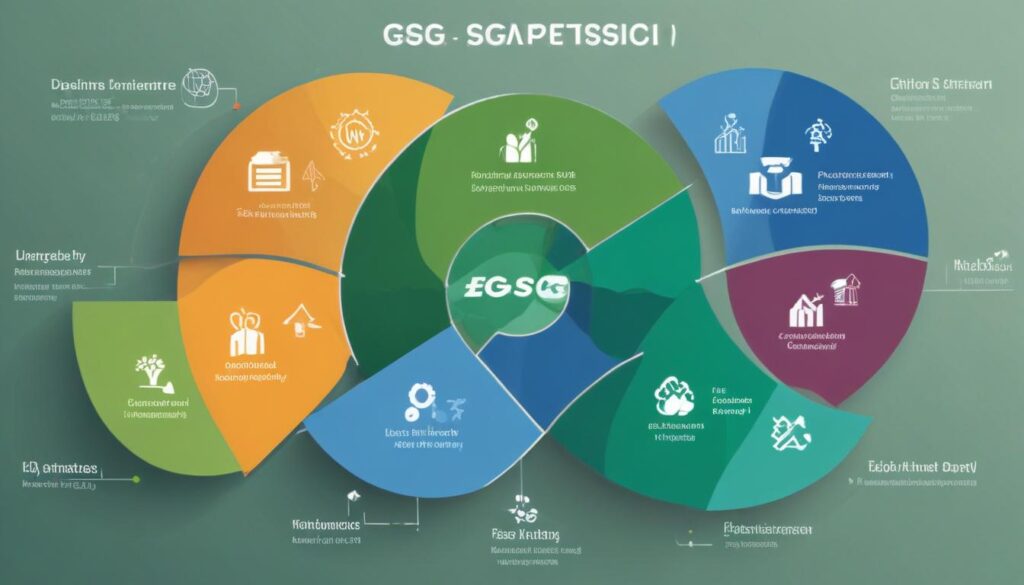The best ESG reports are clear and comprehensive documents that feature a materiality assessment, relevant performance metrics, and transparent communication practices, enabling companies to demonstrate their commitment to sustainability and accountability effectively.
The best ESG reports can offer valuable insights into sustainability. Curious how these reports can shape corporate responsibility and strategy? Let’s explore.
What are the key components of the best ESG reports?
Understanding the key components of the best ESG reports is crucial for organizations aiming to enhance their sustainability practices and transparency.
One essential element is the materiality assessment. This process involves identifying and prioritizing the environmental, social, and governance factors that are most significant to stakeholders. By focusing on these material issues, companies can provide relevant insights that resonate with their audience.
Another critical component is data transparency. High-quality ESG reports present clear and verifiable data, including metrics on carbon emissions, employee diversity, and governance policies. This transparency builds trust and allows stakeholders to evaluate the company’s commitments and performance accurately.
Moreover, a successful ESG report should include stakeholder engagement strategies. Companies need to demonstrate how they have involved stakeholders in the reporting process, including feedback and recommendations. This approach not only enhances credibility but also encourages continuous improvement.
Additionally, it is vital to establish clear goals and performance indicators. Companies should outline specific targets they aim to achieve in their sustainability efforts and provide detailed analysis on their progress towards these goals. This aspect keeps stakeholders informed and engaged regarding the company’s journey.
Here’s a summary of the key components:
- Materiality assessment to prioritize relevant issues;
- Data transparency for verifiable metrics and information;
- Stakeholder engagement strategies to include feedback;
- Clear goals with performance indicators to track progress.
By focusing on these components, organizations can create impactful and meaningful ESG reports that drive accountability and foster a positive reputation.
Source: Global Reporting Initiative, Sustainability Accounting Standards Board
How can companies leverage insights from ESG reports?
Companies can significantly enhance their strategies by effectively leveraging insights from ESG reports. These reports offer a wealth of information that can guide decision-making and improve corporate responsibility.
One of the first steps is to analyze the performance metrics included in the reports. By diving deep into these metrics, companies can identify areas where they excel and where improvement is needed. This analysis can lead to targeted actions that align with sustainability goals.
Furthermore, understanding stakeholder feedback as presented in ESG reports is essential. Companies can utilize this feedback to adapt their business strategies in response to stakeholder concerns. This responsiveness not only builds trust but also fosters a stronger relationship between the company and its stakeholders.
Another key opportunity is the application of insights for risk management. ESG reports help organizations recognize potential risks related to environmental regulations, social responsibilities, and governance challenges. By addressing these risks proactively, companies can mitigate negative impacts on their brand and operations.
Additionally, these reports can serve as a benchmark for setting future goals. By comparing performance against peers and industry standards, companies can establish realistic yet ambitious targets that drive continuous improvement.
In summary, companies can harness insights from ESG reports through:
- In-depth analysis of performance metrics;
- Incorporation of stakeholder feedback into strategies;
- Proactive risk management based on identified challenges;
- Benchmarking against industry standards to set goals.
By adopting a strategic approach to ESG insights, companies can not only enhance their sustainability efforts but also contribute positively to society.
Source: Global Reporting Initiative, Sustainability Accounting Standards Board
What trends are emerging in ESG reporting?

Emerging trends in ESG reporting reflect the increasing importance of sustainability and corporate responsibility in today’s business landscape. These trends help companies adapt to evolving stakeholder expectations and regulatory requirements.
One significant trend is the integration of technology and data analytics in ESG reporting. Organizations are now leveraging advanced tools to collect, analyze, and present data, making reports more insightful and user-friendly. This shift allows for real-time reporting and enhanced transparency regarding sustainability efforts.
Another noteworthy development is the focus on standardization of reporting frameworks. As stakeholders demand consistency and comparability, more companies are adopting global standards such as the Global Reporting Initiative (GRI) and the Sustainability Accounting Standards Board (SASB). These frameworks provide clear guidelines for organizations, making it easier to measure and report on ESG performance.
Furthermore, the emphasis on social equity and governance issues is becoming increasingly prominent in ESG reporting. Companies are now expected to address not only environmental impacts but also social issues such as diversity, equity, and inclusion. This trend highlights the need for businesses to take a holistic approach to sustainability.
Additionally, companies are enhancing their stakeholder engagement practices. By actively involving stakeholders in the reporting process, organizations can gain valuable insights and improve their ESG strategies by addressing concerns and expectations more effectively.
To summarize, here are key trends shaping ESG reporting:
- Increased use of technology and data analytics for insights;
- Adoption of standardized reporting frameworks for consistency;
- Greater focus on social equity and governance issues;
- Enhanced stakeholder engagement in the reporting process.
These trends not only reflect the evolving landscape of corporate responsibility but also guide companies in their journey towards greater sustainability.
Source: Global Reporting Initiative, Sustainability Accounting Standards Board
The impact of ESG reports on corporate transparency
The impact of ESG reports on corporate transparency is profound, reshaping how companies communicate their sustainability efforts to stakeholders. By providing detailed insights into environmental, social, and governance practices, these reports enhance the credibility of organizations.
One major advantage of ESG reporting is the increased trust it fosters among investors and consumers. When companies disclose their ESG data, they allow stakeholders to assess their commitment to sustainable practices, which can lead to stronger relationships and loyalty.
Moreover, ESG reports play a critical role in demonstrating a company’s accountability. By transparently sharing information about performance metrics and challenges, businesses can show they are taking responsibility for their impacts. This level of openness reduces the risk of criticism and strengthens reputational integrity.
Additionally, regulatory compliance is another critical aspect of transparency shaped by ESG reporting. As regulations around sustainability tighten globally, companies are increasingly compelled to align their practices with these guidelines. Comprehensive ESG reports help organizations identify compliance gaps and adjust their strategies accordingly.
Furthermore, these reports can lead to improved internal practices. By being transparent about both successes and shortcomings, organizations can drive change within their corporate cultures, encouraging proactive approaches to sustainability among employees and management.
To summarize the influence of ESG reports on corporate transparency:
- Increased trust and loyalty from stakeholders;
- Enhanced accountability through open communication;
- Alignment with regulatory compliance requirements;
- Improvements in internal practices fostering a culture of sustainability.
By prioritizing transparency through ESG reporting, companies not only fulfill ethical obligations but also position themselves competitively in the marketplace.
Source: Global Reporting Initiative, Sustainability Accounting Standards Board
How to evaluate the effectiveness of ESG reports?
Evaluating the effectiveness of ESG reports is essential for organizations aiming to enhance their sustainability strategies and ensure accountability. This evaluation process involves several key components that contribute to a comprehensive understanding of a company’s ESG performance.
One fundamental approach is to assess the clarity and accessibility of the report. Effective reports should present information in a manner that is easy to understand for stakeholders, using clear language and visual aids, such as graphs and charts, to convey key metrics. This transparency allows stakeholders to quickly grasp the company’s sustainability efforts.
Another important factor is the relevance of metrics included in the report. Businesses need to ensure that the metrics chosen align with industry standards and stakeholder expectations. These should cover aspects such as carbon footprint, diversity, equity, and governance practices, demonstrating a well-rounded approach to sustainability.
Furthermore, evaluating the track record of goals versus actual performance is critical. This involves comparing the targets set in previous reports with the actual outcomes achieved. A consistent track record of meeting or exceeding targets indicates a commitment to ESG principles and enhances credibility.
Stakeholder feedback also plays a crucial role in this evaluation process. Gathering insights from investors, employees, and customers can further refine the effectiveness of an ESG report. Organizations should actively engage with their stakeholders to understand their perspectives and incorporate their feedback in future reports.
To summarize the evaluation process:
- Assess the clarity and accessibility of the report;
- Ensure metrics are relevant and aligned with standards;
- Compare goals set against actual performance;
- Gather and incorporate stakeholder feedback.
By adopting these evaluation criteria, organizations can significantly enhance the effectiveness of their ESG reports, fostering greater accountability and transparency in their sustainability practices.
Source: Global Reporting Initiative, Sustainability Accounting Standards Board
Best practices for writing an ESG report

Implementing best practices for writing an ESG report is crucial for companies seeking to effectively communicate their sustainability efforts and enhance stakeholder engagement. These practices ensure reports are informative, transparent, and aligned with industry standards.
First, starting with a materiality assessment is essential. This process identifies the key environmental, social, and governance issues that matter most to stakeholders. By focusing on these areas, companies can ensure their reports are relevant and impactful.
Next, clarity and transparency should guide the reporting process. Information should be presented in straightforward language, supplemented by visuals such as graphs and infographics. This approach helps readers quickly understand the company’s initiatives and progress.
Additionally, setting specific, measurable goals is vital. Companies should define clear performance indicators for each ESG area and report on their progress toward these targets. This level of detail not only increases accountability but also demonstrates a genuine commitment to sustainability.
It is also beneficial to engage stakeholders throughout the reporting process. This can involve gathering feedback on previous reports or soliciting input on future goals. Engaging stakeholders creates a sense of ownership and can lead to more comprehensive and trustworthy reports.
Lastly, considering external standards and frameworks, such as the Global Reporting Initiative (GRI) or Sustainability Accounting Standards Board (SASB), can enhance a report’s credibility. Aligning with these established guidelines shows adherence to best practices and increases comparability with peers.
To summarize, best practices for writing an ESG report include:
- Conducting a materiality assessment to identify key issues;
- Ensuring clarity and transparency in reporting;
- Setting measurable goals and performance indicators;
- Engaging stakeholders for feedback and input;
- Aligning with external standards and frameworks.
By following these practices, companies can produce compelling ESG reports that effectively convey their sustainability narratives and foster trust among stakeholders.
Source: Global Reporting Initiative, Sustainability Accounting Standards Board
In conclusion, the importance of effective ESG reporting
Effective ESG reporting is crucial for companies that want to demonstrate their commitment to sustainability and accountability. By implementing best practices, organizations can communicate clearly with stakeholders and enhance their reputation.
Choosing relevant metrics, setting measurable goals, and ensuring transparency are vital steps in this process. Engaging with stakeholders helps companies understand their needs and expectations, leading to more impactful reports.
As ESG considerations continue to shape business practices, adapting to these changes is essential for long-term success. Companies that prioritize ESG reporting will not only improve their brand image but also contribute positively to society and the environment.
Ultimately, a strong commitment to sustainability through effective ESG reporting can help organizations thrive in today’s competitive landscape.
Frequently Asked Questions about ESG Reporting
What are the key components of an effective ESG report?
An effective ESG report should include a materiality assessment, clear performance metrics, and a transparent communication style. These components make it easier for stakeholders to understand the company’s sustainability efforts and track progress toward goals.
How can companies use ESG reports to improve their practices?
By analyzing ESG reports, companies can identify strengths and weaknesses in their sustainability practices. For example, if a report reveals low diversity numbers, a company might focus on enhancing its hiring practices to foster a more inclusive workplace.
What role does stakeholder engagement play in ESG reporting?
Stakeholder engagement is vital as it provides insights into what concerns investors, customers, and employees. Actively seeking feedback can help companies tailor their ESG strategies to better meet stakeholder expectations and build stronger relationships.
How do ESG reports affect corporate transparency?
ESG reports enhance corporate transparency by disclosing a company’s environmental performance and governance practices. This openness builds trust with stakeholders, as they can see the tangible efforts made by the company in its sustainability journey.
What best practices should be followed when writing an ESG report?
Best practices include conducting a thorough materiality assessment, ensuring clarity in presenting data, and aligning with established reporting frameworks. These practices help create a comprehensive and professional report that stakeholders can rely on.
How can companies evaluate the effectiveness of their ESG reports?
Companies should assess clarity, relevance of metrics, and stakeholder feedback when evaluating their ESG reports. For instance, tracking whether performance goals are met can highlight areas for improvement and increase the report’s overall effectiveness.


